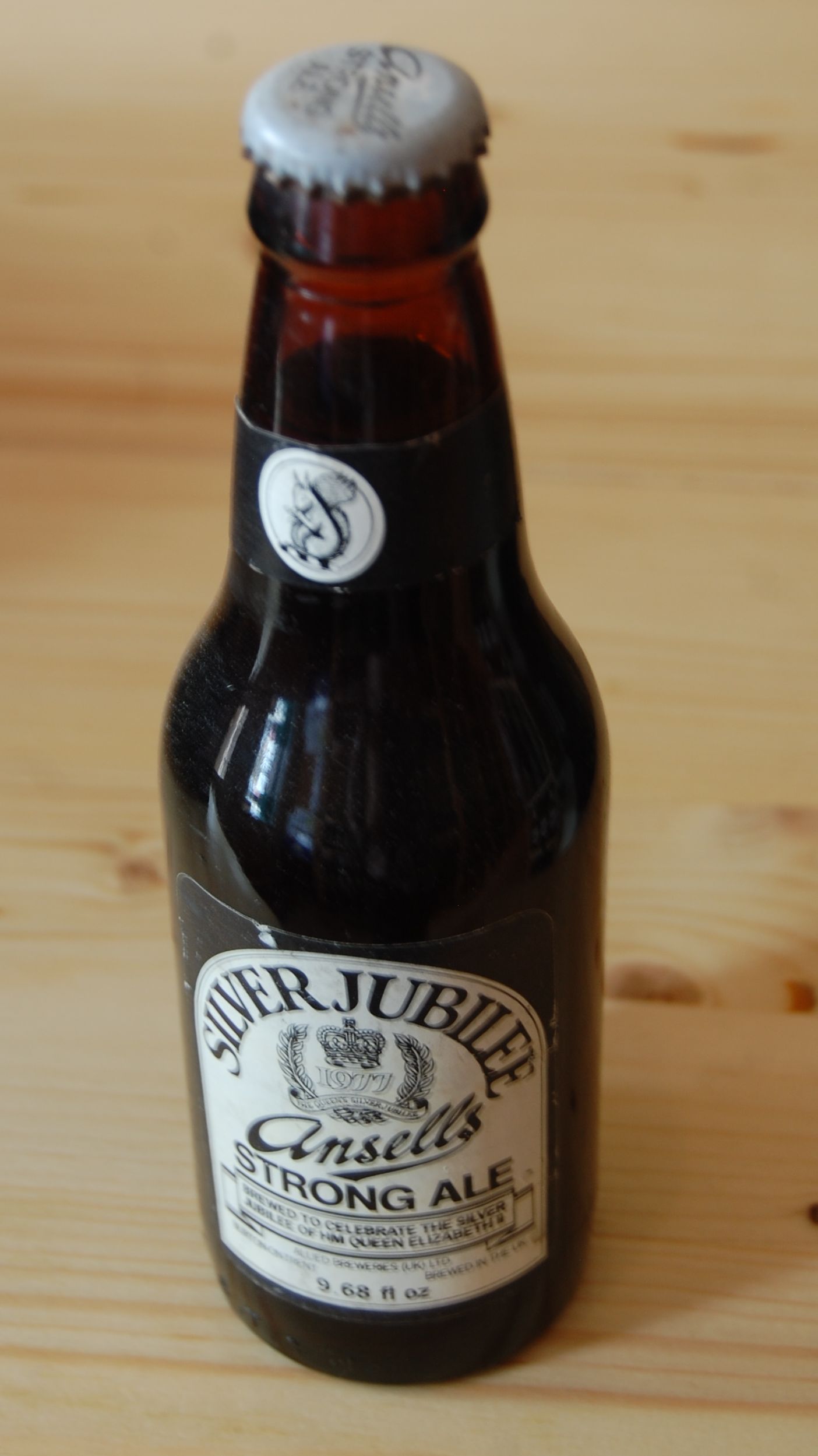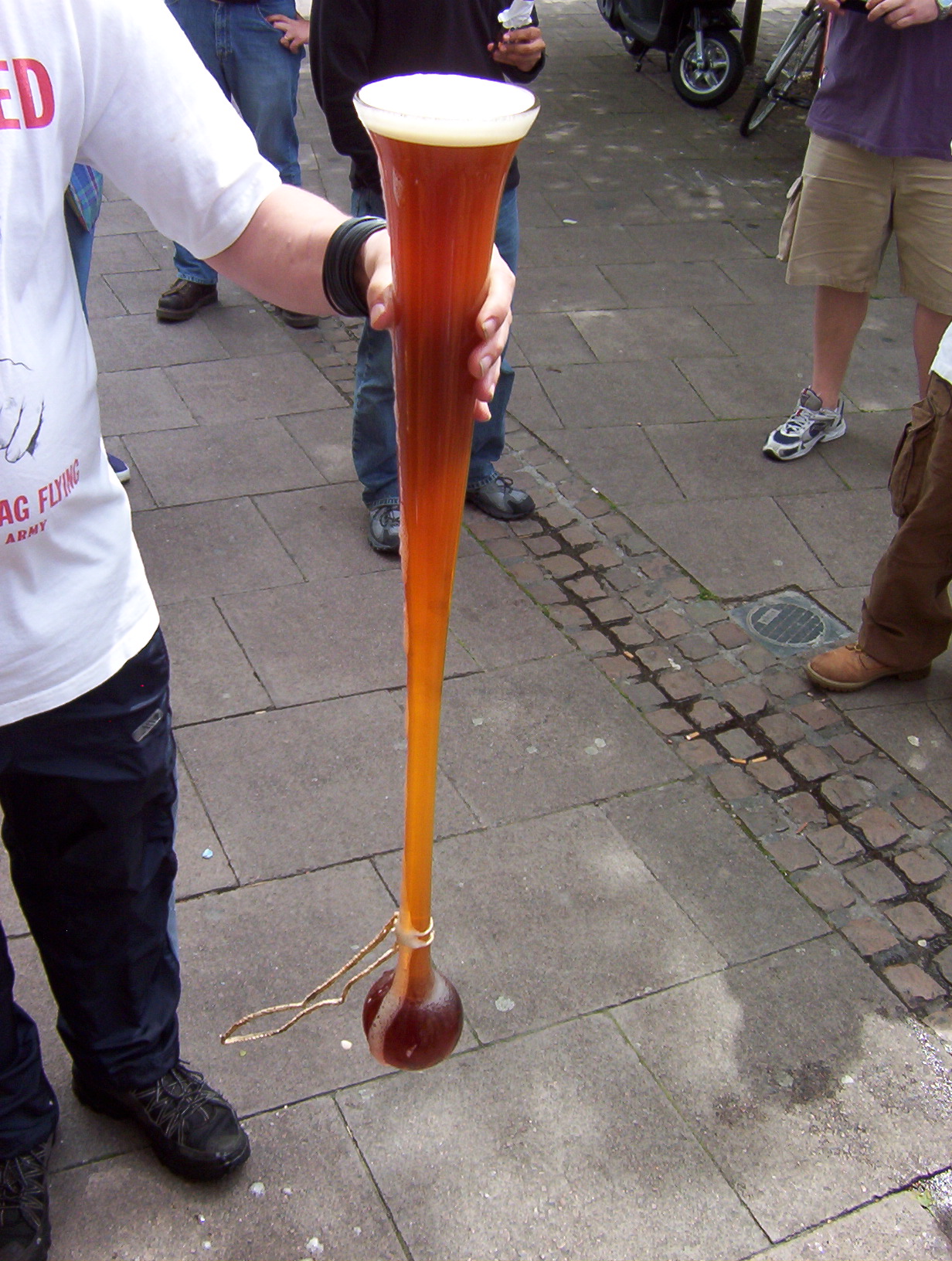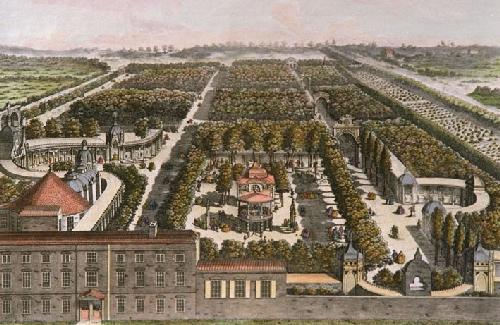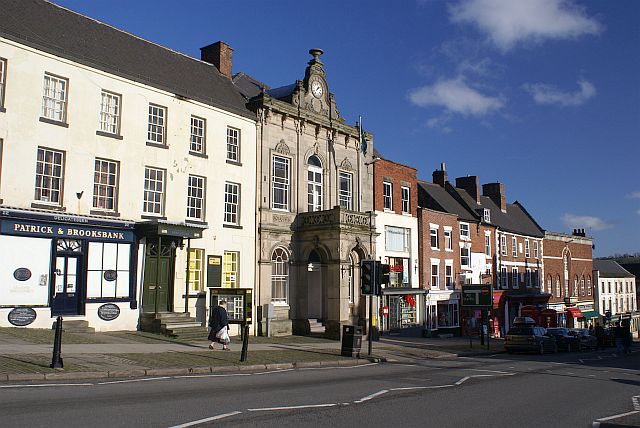|
Burton Ale
Burton ale is a type of strong ale which is dark and sweet. It is named after the brewing town of Burton-on-Trent. Burton ales were generally aged and needed cellaring for months before serving, and almost certainly had some degree of secondary fermentation going on during that time. In London, the terms Burton ale and old ale were interchangeable, but compared to other old ales and barley wines Burton ale is distinctively dark, sweet and fruity. __TOC__ Old Burton Old Burton is a strong version of Burton ale. Allsopp's Arctic Ale, first brewed in 1852 for Captain Edward Belcher's expedition to search for Sir John Franklin, was originally 11.24% ABV. The subsequent McClintock Arctic Expedition also took Burton ale. Old Burton was referenced in The Wind in the Willows: "The Rat, meanwhile, was busy examining the label on one of the beer-bottles. 'I perceive this to be Old Burton', he remarked approvingly. 'Sensible Mole! The very thing!" Burton ale Like most mediaeval religio ... [...More Info...] [...Related Items...] OR: [Wikipedia] [Google] [Baidu] |
Strong Ale
Strong ale is a type of ale, usually above 5% abv and often higher, between 7% to 11% abv, which spans a number of beer styles, including old ale, barley wine and Burton ale. Strong ales are brewed throughout Europe and beyond, including in England, Belgium and the United States. "Scotch ale" was first used as a designation for strong ales exported from Edinburgh in the 18th century. Scotch ale is sometimes conflated with the term "wee heavy", as both are used to describe a strong beer. Beers brewed in the US under the name "wee heavy" tend to be 7% abv and higher, while Scottish-brewed examples, such as Belhaven's Wee Heavy, are between 5.5% and 6.5% abv. McEwan's Scotch Ale is also 8% abv. See also * Christmas beer * List of beer styles * Trappist beer Trappist beer is brewed by Trappist monks. Thirteen Trappist monasteries—six in Belgium, two in the Netherlands, and one each in Austria, Italy, England, France, and Spain—currently produce beer, but the ''Authentic Tra ... [...More Info...] [...Related Items...] OR: [Wikipedia] [Google] [Baidu] |
River Trent
The Trent is the Longest rivers of the United Kingdom, third-longest river in the United Kingdom. Its Source (river or stream), source is in Staffordshire, on the southern edge of Biddulph Moor. It flows through and drains the North Midlands. The river is known for dramatic flooding after storms and spring snowmelt, which in the past often caused the river to change course. The river passes through Stoke-on-Trent, Stone, Staffordshire , Stone, Rugeley, Burton upon Trent and Nottingham before joining the River Ouse, Yorkshire, River Ouse at Trent Falls to form the Humber Estuary, which empties into the North Sea between Kingston upon Hull, Hull in Yorkshire and Immingham in Lincolnshire. The wide Humber estuary has often been described as the boundary between the Midlands and the north of England. Name The name "Trent" is possibly from a Romano-British word meaning "strongly flooding". More specifically, the name may be a contraction of two Romano-British words, ''tros'' (" ... [...More Info...] [...Related Items...] OR: [Wikipedia] [Google] [Baidu] |
Catherine II By J
Katherine, also spelled Catherine, and other variations are feminine names. They are popular in Christian countries because of their derivation from the name of one of the first Christian saints, Catherine of Alexandria. In the early Christian era it came to be associated with the Greek adjective (), meaning "pure", leading to the alternative spellings ''Katharine'' and ''Katherine''. The former spelling, with a middle ''a'', was more common in the past and is currently more popular in the United States than in Britain. ''Katherine'', with a middle ''e'', was first recorded in England in 1196 after being brought back from the Crusades. Popularity and variations English In Britain and the U.S., ''Catherine'' and its variants have been among the 100 most popular names since 1880. The most common variants are ''Katherine,'' ''Kathryn,'' and ''Katharine''. The spelling ''Catherine'' is common in both English and French. Less-common variants in English include ''Katheryn'', ... [...More Info...] [...Related Items...] OR: [Wikipedia] [Google] [Baidu] |
Yard Of Ale
A yard of ale or yard glass is a very tall beer glass used for drinking around of beer, depending upon the diameter. The glass is approximately long, shaped with a bulb at the bottom, and a widening shaft, which constitutes most of the height. The glass most likely originated in 17th-century England, where the glass was known also as a "long glass", a "Cambridge yard (glass)" and an "ell glass". It is associated by legend with stagecoach drivers, though was mainly used for drinking feats and special toasts. Drinking a yard glass full of beer as quickly as possible is a traditional pub game; the bulb at the bottom of the glass makes it likely that the contestant will be splashed with a sudden rush of beer towards the end of the feat. The fastest drinking of a yard of ale in the ''Guinness Book of Records'' is 5 seconds. Description The glass is approximately , shaped with a bulb at the bottom and a widening shaft, which constitutes most of the height. In countries where the ... [...More Info...] [...Related Items...] OR: [Wikipedia] [Google] [Baidu] |
City Of London
The City of London is a city, ceremonial county and local government district that contains the historic centre and constitutes, alongside Canary Wharf, the primary central business district (CBD) of London. It constituted most of London from its settlement by the Romans in the 1st century AD to the Middle Ages, but the modern area named London has since grown far beyond the City of London boundary. The City is now only a small part of the metropolis of Greater London, though it remains a notable part of central London. Administratively, the City of London is not one of the London boroughs, a status reserved for the other 32 districts (including Greater London's only other city, the City of Westminster). It is also a separate ceremonial county, being an enclave surrounded by Greater London, and is the smallest ceremonial county in the United Kingdom. The City of London is widely referred to simply as the City (differentiated from the phrase "the city of London" by ca ... [...More Info...] [...Related Items...] OR: [Wikipedia] [Google] [Baidu] |
Vauxhall Gardens
Vauxhall Gardens is a public park in Kennington in the London Borough of Lambeth, England, on the south bank of the River Thames. Originally known as New Spring Gardens, it is believed to have opened before the Restoration of 1660, being mentioned by Samuel Pepys in 1662. From 1785 to 1859, the site was known as Vauxhall, a pleasure garden and one of the leading venues for public entertainment in London from the mid-17th century to the mid-19th century. The Gardens consisted of several acres of trees and shrubs with attractive walks. Initially entrance was free, with food and drink being sold to support the venture. It was accessed by boat until the erection of Vauxhall Bridge in the 1810s. The area was absorbed into the metropolis as the city expanded in the early to mid-19th century. The site became Vauxhall Gardens in 1785 and admission was charged for its attractions. The Gardens drew enormous crowds, with its paths being noted for romantic assignations. Tightrope wal ... [...More Info...] [...Related Items...] OR: [Wikipedia] [Google] [Baidu] |
Vauxhall Gardens By Samuel Wale C1751
Vauxhall ( ) is a district in South West London, part of the London Borough of Lambeth, England. Vauxhall was part of Surrey until 1889 when the County of London was created. Named after a medieval manor, "Fox Hall", it became well known for the Vauxhall Pleasure Gardens. From the Victorian period until the mid-20th century, Vauxhall was a mixed industrial and residential area, of predominantly manual workers' homes, many demolished and replaced by Lambeth Council with social housing after the Second World War, and business premises, including large railway, gas, and water works. These industries contrasted with the mostly residential neighbouring districts of Kennington and Pimlico. As in neighbouring Battersea and Nine Elms, riverside redevelopment has converted most former industrial sites into residential properties and new office space. Vauxhall has given its name to the Vauxhall parliamentary constituency and Vauxhall Motors. Geography Vauxhall is south of Charing Cro ... [...More Info...] [...Related Items...] OR: [Wikipedia] [Google] [Baidu] |
John Stevenson Bushnan
John Stevenson Bushnan (1807–1884) was an English physician and medical writer. Life He was born in London, the eldest child of Joseph Bushnan, an official of the City of London, and his wife, Mary Newton, née Osborn. He passed at Edinburgh in 1830 the examinations of the Royal College of Surgeons and of the Royal College of Physicians. Marrying, Bushnan lived in Dumfries in the Scottish Borders; and did some work for the Society for the Diffusion of Useful Knowledge. He then had a period studying at Heidelberg, where he graduated M.D, in 1836. Returning to England, he went into practice at Castle Cary in Somerset. Bushnan was then abroad, from 1841, to 1848. Eventually he settled in London, where he filled the post of editor of the ''Medical Times and Gazette'' from 1849 to 1852. Then for one year he was chief physician of the Metropolitan Free Hospital. In 1852 also he became medical superintendent at Wyke House Asylum, a post he held for five years. He then bought his way ... [...More Info...] [...Related Items...] OR: [Wikipedia] [Google] [Baidu] |
The Compleat Angler
''The Compleat Angler'' (the spelling is sometimes modernised to ''The Complete Angler'', though this spelling also occurs in first editions) is a book by Izaak Walton. It was first published in 1653 by Richard Marriot in London. Walton continued to add to it for a quarter of a century. It is a celebration of the art and spirit of fishing in prose and verse. It was illustrated by Arthur Rackham in 1931. Background Walton was born in Stafford and moved to London when he was in his teens in order to learn a trade. ''The Compleat Angler'' reflects the author's connections with these two locations, especially on the River Dove, Central England that forms the border between Staffordshire and Derbyshire in the Peak District. The book was dedicated to John Offley of Madeley, Staffordshire, and there are references in it to fishing in the English Midlands. However, the work begins with Londoners making a fishing trip up the Lea Valley in Hertfordshire, starting at Tottenham. Walton w ... [...More Info...] [...Related Items...] OR: [Wikipedia] [Google] [Baidu] |
Ashbourne, Derbyshire
Ashbourne is a market town in the Derbyshire Dales district in Derbyshire, England. Its population was measured at 8,377 in the 2011 census and was estimated to have grown to 9,163 by 2019. It has many historical buildings and independent shops. The town offers a historic annual Shrovetide football match. Its position near the southern edge of the Peak District makes it the closest town to Dovedale, to which Ashbourne is sometimes referred to as the gateway. The town is west of Derby, south-east of Buxton, east of Stoke-on-Trent, south-south-east of Manchester, south-west of Sheffield and north of Lichfield. Nearby towns include Matlock, Uttoxeter, Leek, Cheadle and Bakewell. History The town's name derives from the Old English ''æsc-burna'' meaning "stream with ash trees". Ashbourne was granted a market charter in 1257. In medieval times it was a frequent rest stop for pilgrims walking "St Non's Way" to the shrine of Saint Fremund at Dunstable in Bedfordshire. T ... [...More Info...] [...Related Items...] OR: [Wikipedia] [Google] [Baidu] |
John Taylor (poet)
John Taylor (24 August 1578 – December 1653) was an English poet who dubbed himself "The Water Poet". Biography John Taylor was born in the parish of St. Ewen's, near South Gate, Gloucester on 24 August 1578. His parentage is unknown, as the parish registers did not survive the Civil War. He did, however, attend elementary school and grammar school there. His grammar school education may have taken place at the Crypt School in Gloucester, however Taylor never finished his formal education as Latin bested him. In the early 1590s, after his attempt at grammar school he moved from his home to south London, probably Southwark, to begin an apprenticeship as a waterman. His occupation was one deemed unpopular by the literary elite of London. Watermen were known to be drunkards, and often gossips and liars, who attempted to cheat patrons into a higher wage for their service. This occupation would be crafted into an image for Taylor later in his career. After his waterman apprentice ... [...More Info...] [...Related Items...] OR: [Wikipedia] [Google] [Baidu] |






_(title_page).jpg)

